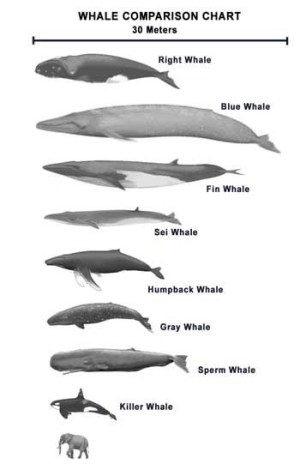Interstellar travel (from the International Herald Tribune Aug 18, 2011)
“If you want to have a hobby, why can’t it be designing an interstellar spacecraft?” said Andreas Tziolas, who teaches at the University of Alaska and directs Project Icarus, a worldwide volunteer effort to design a spacecraft that could carry a scientific probe to a nearby star – perhaps Alpha Centauri, 4.4 light-years from here – in a trip that would take less than 100 years.
It would take Voyager 1, humanity’s fastest artifacy, now traveling 38,000 miles per hour, or 61,000 kilometers per hour, relative to the Sun, more than 70,000 years to reach Alpha Centauri.
Last year Marc G. Millis, who directed propulsion research at NASA’s Glenn Research Centre in Cleveland, to encourage work on “practical interstellar flight,” calculated that it would be at least 200 years before society had the energy resources to send 500 people out of the solar system.
Whale watching (from Sawubona, in-flight magazine of the
South African Airways August 2011) and selling Zimbabwean elephants to DPRK
Whale watching is one of the most powerful tools in our conservation arsenal to protect whales. It has become a billion dollar industry, and almost 10 million people from as many as 90 countries participate worldwide. A Southern Right Whale calf consumes over 100 litres of milk daily and grows at a giant’s rate of 2.8 cm a day for almost four months.

Vitalis Chadenga, head of the Zimbabwe Parks and Wildlife Management Authority, or ZPWMA: “We have more than 100,000 elephants in our national parks. We will sell them to anyone if they approach us . The North Koreans paid for these animal species. The two baby elephants were sold for US$10,000 each.”
Baobabs in South Africa and Armenian wine presses
(from Sawubona, in-flight magazine of the South African Airways August 2011)
It’s generally accepted that any baobab with a circumference of more than 30 m is older than 3,000 years. The tree, accommodating the Big Baobab Bar, situated just outside the town of Modjadjiskloof, not far from the Limpopo town of Tzaneen in South Africa, is around 6,000 years old. The Giza pyramids had not yet been built in Egypt – and wouldn’t be for another 3,000 years, in other words. This South African baobab is about the same age as the world’s very first wine press in southern Armenia.
Fresh water globally (Financial Times August 18, 2011)
Nick Butler, chair of the Kings Policy Institute at Kings College London, and Ian Pearson, a strategy consultant and former UK government minister:
The global population is expanding by 200,000 people a day, which results in global consumption of fresh water rising by more than 60,000 billion litres a year. Yet more than one billion people are without a safe supply. This is compounded by issues such as the unsustainable exploitation of fresh water and desertification – where the Sahara advances south by more than 40 km a year.
With the ice cap receding, ship operators are now eyeing a route across the North Pole that would shave as much as 7,000 km off the existing sailing distance between Rotterdam and Tokyo via the Suez Canal. Two German cargo vessels, helped by icebreakers, completed the short polar voyage in 2009.


